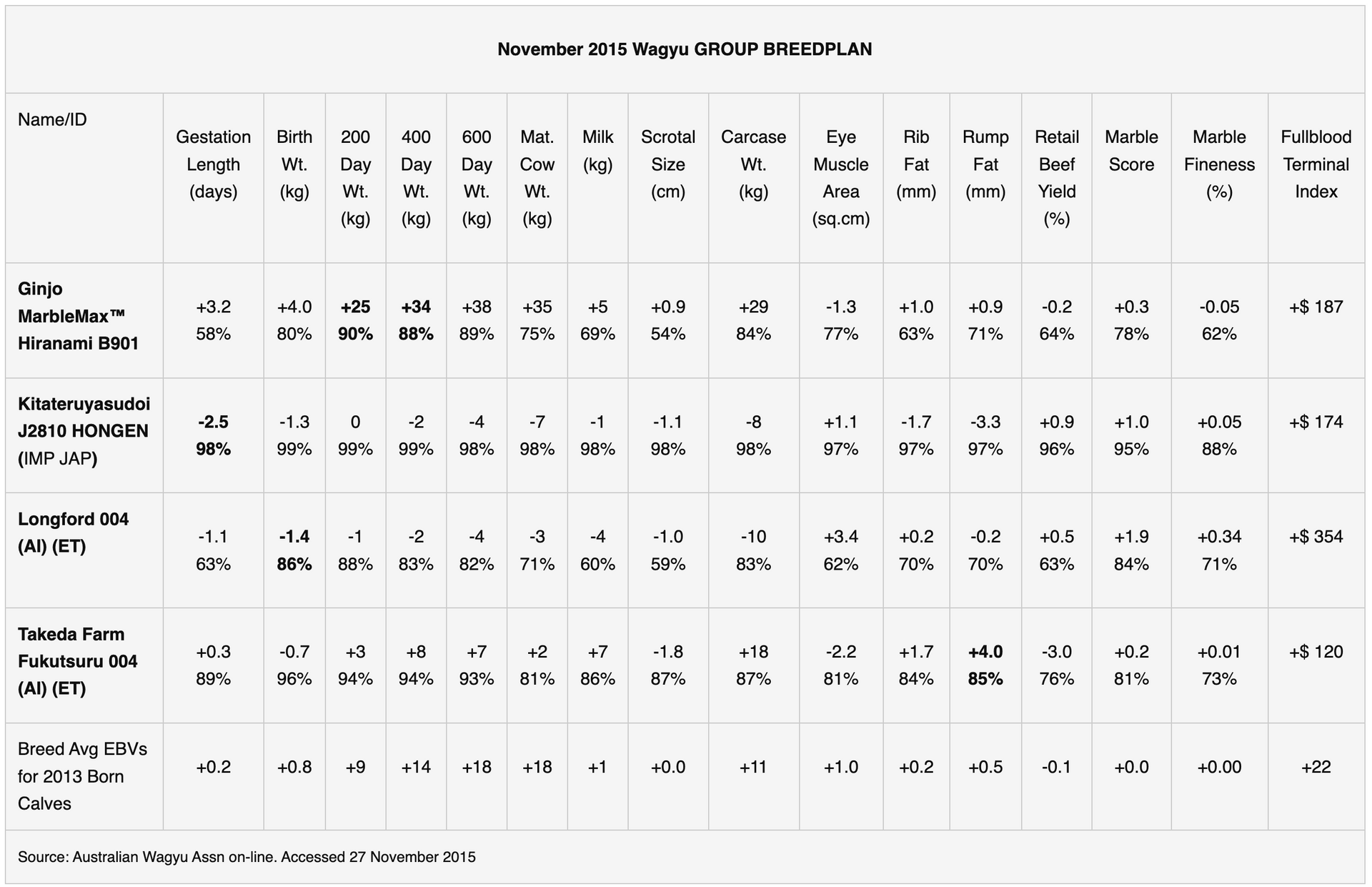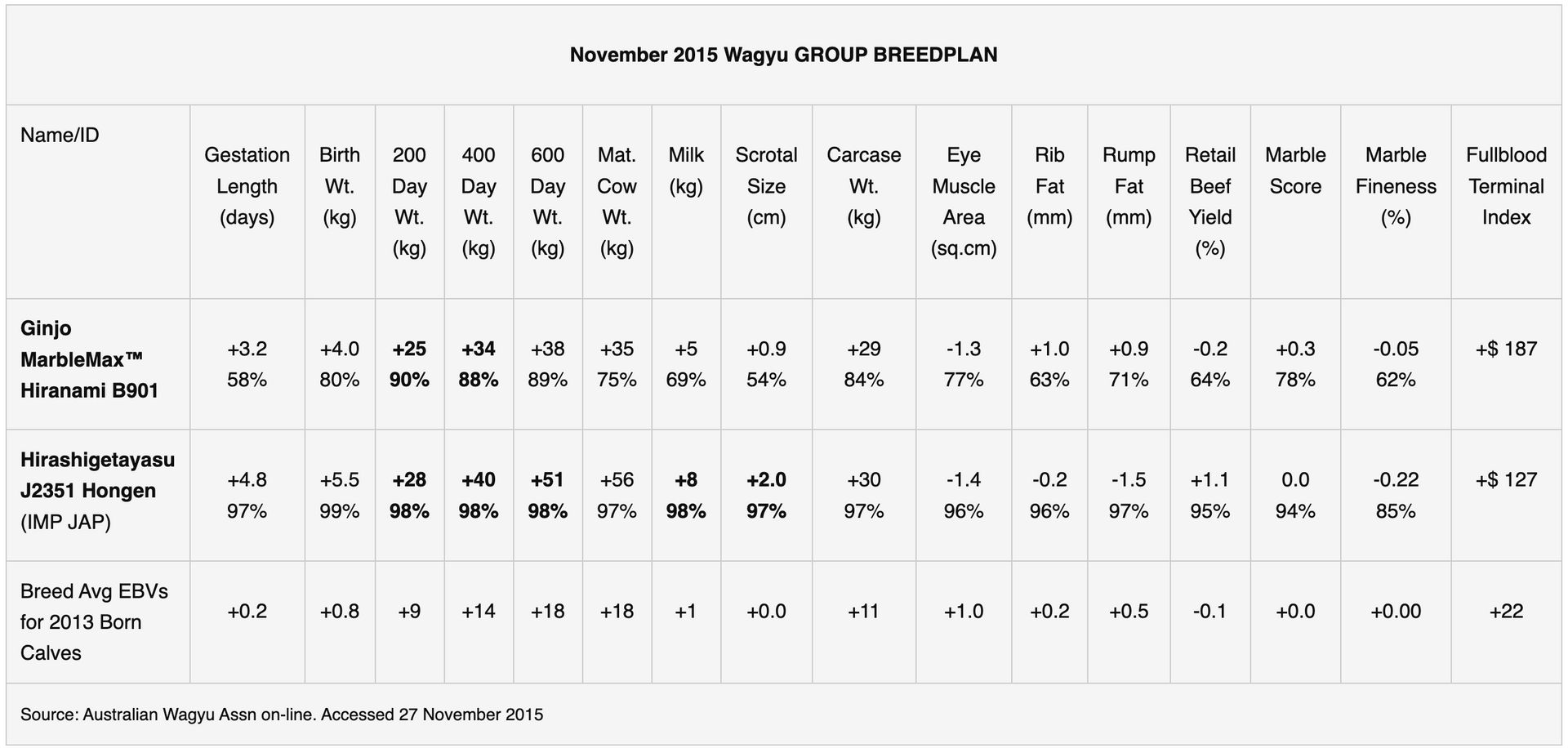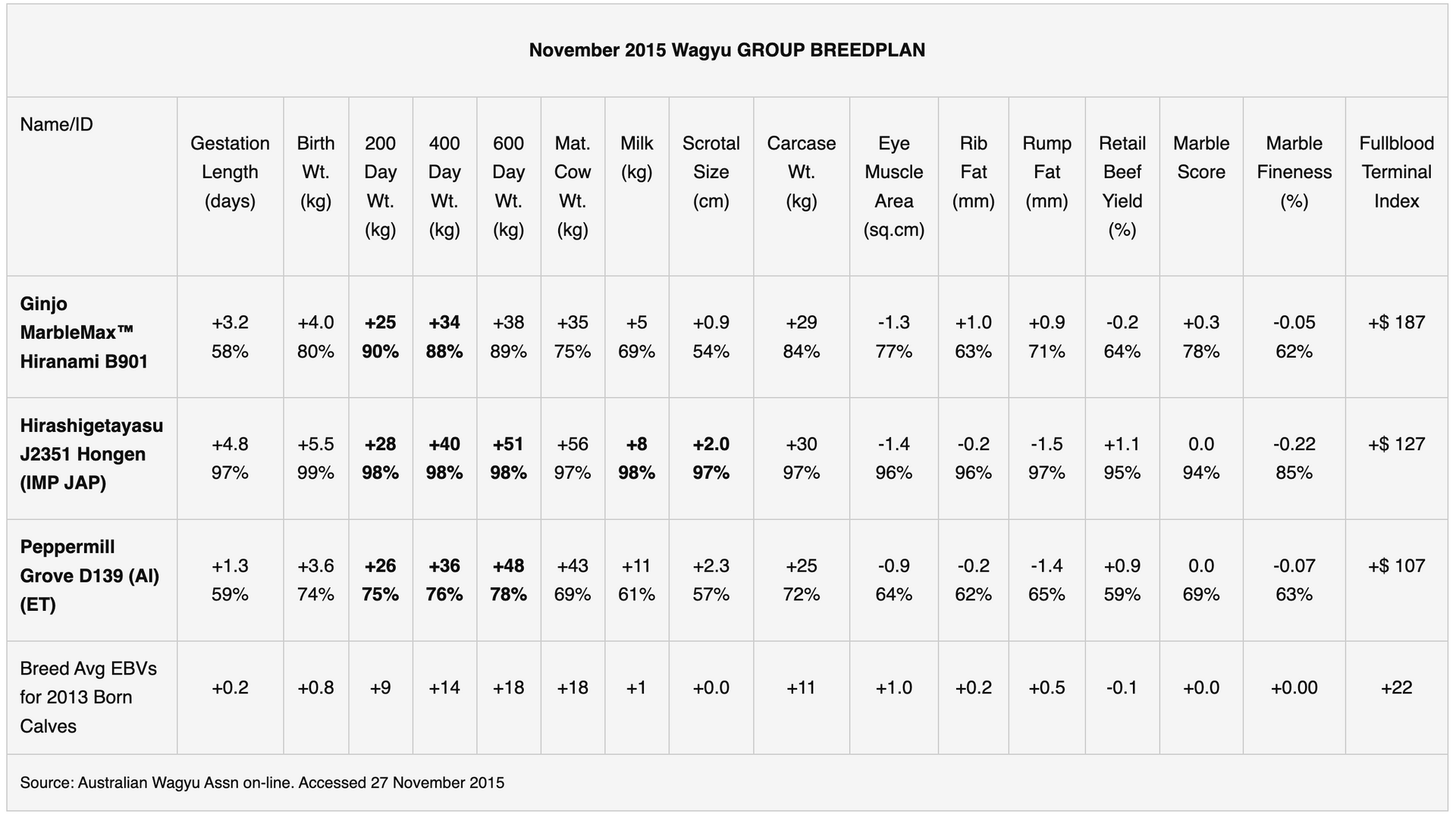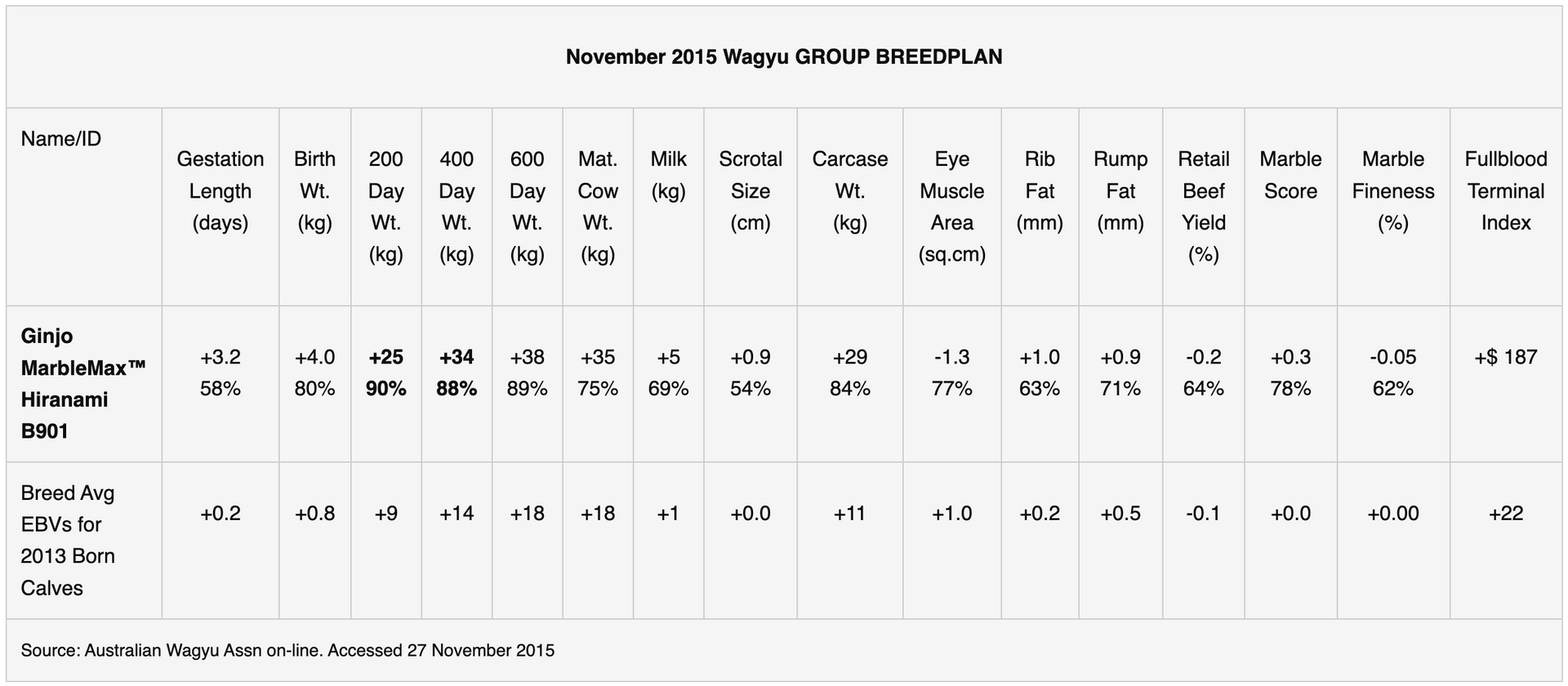World Class Black Wagyu AI Sires
Until recently, fullblood Japanese Black sires were generally categorised in the Australian Wagyu breeding community as either ‘growth’, or ‘marbling’. Given the keen focus on F1 breeding in early Australian production, ‘growth’ sires were historically used for building frame in F1 herd bulls, in which the real marbling target was addressed by including high percentages of Tajima (Hyogo Prefecture) bloodlines. Very little or no emphasis was placed on the breeding of consistent, high performance fullblood breeders.
Today, with a commercially viable fullblood sector and new carcass-data enriched BREEDPLAN EBVs supporting superior selection, a small, third category of more versatile fullblood sires is emerging: delivering enhanced early growth to meet the needs of feeder producers, but maintaining consistent high marble scores, and maximised carcass profitability. And in parts of this group, excellent progeny predictability is now apparent not just for feeder growth or carcasses, but also for production of a new generation of more versatile dams.
So the Australian FB sire selection landscape has changed and the key sire selection categories are:
- Terminal sires: For either F1 or fullblood production, promising improved marbling outcomes in vertically integrated production when breeding 100% feeder/slaughter groups, – but often with poor trait development predicted for breeder replacement, and poor early growth predictions for cow/calf producers who sell feeder animals. This terminal sire group is currently identified in the Australian Wagyu Assn FTI (Fullblood Terminal Index), discussed in more detail on this site here.
- ‘New Generation’ All-Round Performance Sires: As defined in the “All Round Sire Selection Parameters” table below, these sires are capable of delivering early growth performance for feeder producers, commercial carcass performance for feedlotters and processors, plus a new generation of quality breeders.
- Traditional ‘Growth/Frame’ Sires: This group comprises largely ‘original import’ sires in the first generation of the Australian and US fullblood Japanese Black herds, used for building frame in otherwise ‘high Tajima’ herd bulls, often in terminal production.
Identifying Key Traits
All-Round Performance Sires
Unlike the Terminal sire, where the emphasis is heavily on the endpoint carcass marbling, and there is little or no consideration given to early growth or maternal traits, the ‘All-Round’ fullblood sire must deliver key benefits in each of three segments in the fullblood Wagyu supply chain.
- For the cow/calf operator producing feeders and replacements, the cost and time of getting a feeder steer or heifer to feedlot induction weight is a key profitability determinant, so weaning/200/400 day weight performance is mission critical. This requires maternal (milk) traits and solid growth
- For the vertical producer, 600 day weights, carcass weights and marble score will determine final profit/loss.
If the cow/calf operator delivers feeders that do not perform at the feedlot, the future of the both businesses is jeopardised. But for the cow/calf operator, producing feeders to a low-growth, high marbling Terminal Sire may be an even faster route to insolvency.
Following is a snapshot of key traits:
High Value EBV Traits Review By Production Segment
(Click for larger picture).
Importance of EBV % Accuracy Values
Wagyu BREEDPLAN EBVs are compiled from thousands of individual animal records. The more records, the more accurate the EBV prediction is likely to be. To assist users, ABRI provides the following guidelines to the use of the %ACC values used in individual animal EBV records.
Importance of EBV % Accuracy Values
(Click for larger picture).
Given the high cost of error in selecting Wagyu sires, we suggest a minimum entry point of 75% accuracy in EBVs to support selection at a commercial level of joinings. A further hidden factor in evaluating Wagyu BREEDPLAN EBVs is the notation at the bottom of each animal pedigree on the AWA site: ‘Statistics: No of Herds’. No measurement indicators are provided, but if an animal’s performance is based in just one herd, then no versatility is demonstrated and other factors may be in play. To quote a prominent geneticist: “if there is only one herd of record, maybe buy 20 straws instead of a thousand, first up.”
Using BREEDPLAN EBVs
Selecting The ‘Best All-Round’ Japanese Black Sire
The next step is to define a 75%ACC ‘All Round’ sire short list. As we are looking for an AI sire, an obvious pre-requisite is that the sire must have ‘semen available’ – generally noted in its AWA listing, and a selectable field in the EBV search.. In applying individual EBV values, especially in the area of Marble Score, given the small increments in values (often 0.1 steps) our search regards a value of +0.1 as double the value of a ‘Breed Average’ value of 0.0, which itself equated to an AUS-MEAT marble score of MS 7.8.
The following Australian Wagyu Association EBV tables demonstrating this search for specific sire performance are used in accordance with the published guidelines of the developer, ABRI. ABRI stresses that these EBVs were compiled from data supplied by breeders and neither AWA nor ABRI oversee or audit the collection of the data.
Marble Score Selection
We start with marbling as the premier Wagyu requirement, noting that this single carcase trait focus is a ‘Terminal Sire’ search. The four sire summary below is the total short list that the AWA database delivers in a search for ‘sires with semen available’ with a minimum 75% accuracy for a minimum Marble Score EBV of +0.2 or more. We are aware of a few more with semen availability that are not advertised. 0.0 is the 2013 drop Marble Score EBV average.
At the search date there were about 50 Australian registered Japanese Black sires with a 75%ACC Marble Score EBV +0.2 or better, but only this four with ‘semen available’. At 95%, Kitateruyasudoi (003) has the greatest %ACC and can be regarded as highly reliable. Like many of the other 40+ high marble score EBV sires, three of these semen-available sires also show negative 200/400/600 day growth values related the 2013 breed average.
Marble Score Selection
(Click for larger picture).
Carcass Weight Selection
In a terminal sire index, and in FB production generally, the second most valuable trait is CWT (Carcase Wt). The two sire summary below comprises AWA’s very top ranked two sires for this trait with these parameters: CWT +29 or more at minimum 75% accuracy, with semen available. Only one of the two has a positive (+) Marble Score EBV value, and B901 is also a son of Hirashigetayasu.
Carcass Weight
(Click for larger picture).
Early Growth Selection – 200/400/600 Day WT EBV
This is the key profit driver in cow/calf operations where feeders are sold on weight. The table below identifies the top ranked three Japanese Black sires (recorded by AWA as ‘with semen available’) in Australia sires for early progeny growth at each of the 200 (EBV +25 or more), 400 (EBV +34 or more) and 600 (EBV +38 or more) day measurement points, with a minimum 75% accuracy.
Superior growth at 200-400 days delivers calves to market earlier, and potentially at significantly less feed cost. The 200 day value is also an indicator of dam maternal capability. The Terminal Index value here is insignificant, but only one sire, B901, has a positive ‘+value’ for marble score.
Early Growth
(Click for larger picture).
Best All Round Sire Selection – With (or without) Semen Available
We then combined all of the above searches, retaining minimum 75% Accuracy, but then also removed the requirement for ‘semen is available’, so in theory we would get ‘top rank in entire herdbook’ for a Japanese Black sire.
The considerably less rigorous parameters selected for this search were: Double or more the 2013-Born Breed Average EBVs for 200, 400 & 600 day weight; double or more carcass weight and marble score breed averages (at increments of 0.1). Only one sire came up. Then we added a minimum five times the breed average for Milk (@>65%ACC). And we got the same sire again: Ginjo MarbleMax™ Hiranami B901.
Under the parameters tested above, this sire can stake a highly credible claim to ‘best all round’ AI breeding selection by Wagyu BREEDPLAN EBVs.
Best All Round Sire Selection
(Click for larger picture).
Let’s Talk About Your Wagyu Breeding Plan
We'll Find the Right Wagyu Breeding Solution for You
Call us:






